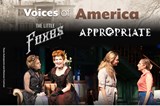By Brian Robin
Dominique Fawn Hill—Zen and Art of Costume Design
Costume designer Dominique Fawn Hill’s webpage has many moments of Zen that help define her design philosophy. They’re not hard to find. You just have to look at each play she has designed, see the renderings and photos and read a short blurb on the play.
Then your moment of Zen arrives. Hill lists her design inspiration for each play. It makes you stop and think, which is the point—for both Hill and those curious about her designs.
For example, for her designs for One Night in Miami, chronicling one night where Malcolm X, Cassius Clay, Jim Brown and Sam Cooke met in a hotel room to escape the world around them, she told herself “Design them as mere mortals.” For School Girls; Or, the African Mean Girls Play, Hill told herself, “Allow everyone to be their own version of The Prom Queen.” For Mlima’s Tale, “If currency had a soul, what would it look like?”
It’s not on her website yet, but Hill’s design inspiration for Lillian Hellman’s The Little Foxes would be “How would the birds sing if they knew they were in a cage?”
“That’s the overall theme for this production,” she said. “Everyone in The Little Foxes is trying to get up on the other person. Regina is trying to get out of her marriage and find some type of currency for herself. Alexandra dreams of not being married to her first cousin and of being independent. Birdie dreams of getting out of the domestic violence situation she’s in and being seen. The men dream of making big money. Some of the men dream of expanding their numbers of indentured servants.
“Everyone is trying to find a way to get over on the other person, but they don’t realize they’re caged themselves. Coming back to the house is a source of drama and turmoil, but they don’t see that it’s a cage.”
Hill’s designs are uncaged. You can see her creative design work on both The Little Foxes and Appropriate, the Obie Award-winning play by Branden Jacobs-Jenkins. Her Edwardian Era designs for The Little Foxes flow in stark contrast with her modern designs for Appropriate. This dichotomy of designing for two shows alternating performances with an overlapping cast—six actors are in both plays—created a challenge for Hill that few of her other works presented.
“It was pretty gnarly. You have to turn your brain off and on,” she said. “You have to go from 1900 Edwardian to 2000 around the same cast. You have to tell your brain to switch. You have to realize the same detail work you did in The Little Foxes you can’t do in Appropriate. The Appropriate characters are more agile and there’s more movement. You can’t do accessories in Appropriate because of that fight scene.
“Finding that balance was a creative challenge because both shows demanded a lot. … It was definitely very challenging, but it allowed me to refine my tool kit in terms of having multiple conversations with directors and assistants and be able to widen my arsenal of creativity.”
That included designing around a forest green set. She had to ensure her color palette did not make the actors disappear, while at the same time, looking realistic for both time periods.
The Little Foxes presented a challenge. Director Lisa Peterson told Hill she wanted a sleek, yet authentic look for 1900 that went back to Peterson’s vision that The Little Foxes was a horror play of sorts. As usual, Hill did plenty of research which revealed that a sleek look for the Victorian Era—which 1900 was a part of—was an oxymoron. Victorian Era clothes were frilly and the antithesis of the sleek, streamlined autonomy Peterson told Hill she wanted.
So Hill proposed a time warp: jump ahead 10 years in terms of fashion styles and go Edwardian. No frills, more sleek and sharper-edged—much like Hellman’s work.
“We wanted each act to be exciting and each act is a total different design concept under the Edwardian Era,” she said. “The first act is done in evening wear. A newcomer comes in from out of town and they mention his clothes look exciting and he’s sharp. Someone comes in as a disruptor and it sets a trend. So when they watch the show, they see a particular person wearing colors that set a trend for the second act. The final act will be where they get toward what Lisa’s original vision was.
“Looking at Lisa’s vision, the Victorian Era frilly ended around 1901 (when Queen Victoria died). We started with the cast and looking at their bodies, because the body is primary. Seeing what their heights and statures were and what would look good on them. I broke down the characters. The leading lady (Shannon Cochran as Regina Giddens) needs to be sharp and intimidating. Her color choices and silhouettes were intentional to reflect that. Her daughter (Jess Andrews as Alexandra) dreams of a life outside of her mother, so her designs were soft and firm. Birdie (Tessa Auberjonois) is a dreamer. Each of them has a strict color palette to reflect that.”
Solving these challenges is what brought Hill to costume design. She started out as a criminal justice major at the University of Albany, but that type of problem-solving didn’t click. She went back to her childhood growing up in the Bronx, where she would watch people and make up stories about them in her mind. Every story would have a problem needing a solution.
“I was an introvert. … so when I decided criminal justice wasn’t for me, I transferred my investigative spirit into clothing,” she said.
That investigative spirit is where the Zen in Hill’s designs came from. It all works together, much like her designs for Voices of America, running now through Feb. 26 on the Segerstrom Stage.


